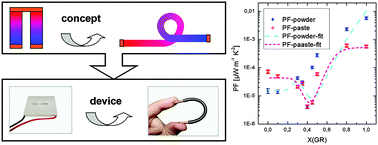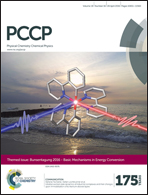Adjusting the thermoelectric properties of copper(i) oxide–graphite–polymer pastes and the applications of such flexible composites†
Abstract
We present a facile alternative to other well known strategies for synthesizing flexible thermoelectric materials. Instead of printing thin active layers on flexible substrates or doping conductive polymers, we produce thermoelectric pastes, using a mixture of graphite, copper(I) oxide and polychlorotrifluoroethene. The Seebeck coefficient of the investigated pastes varies between 10 and 600 μV K−1, while the electrical conductivity spans over an even wider range of 10−4 to 102 S m−1. Here, the influence of phenomena such as percolation on the electrical transport is revealed. The resulting power factor reaches 5.69 × 10−4 ± 0.70 × 10−4 μW m−1 K−2 for the graphite–polymer paste, with an unexpected minimum at a graphite molar fraction of approximately 0.4. The values are comparable to those of the powder mixtures, which are slightly higher, but less precisely tunable. Such compounds are further evaluated for practical applications. The graphite–polymer paste is used to exemplify, how a flexible thermoelectric sensor can be easily manufactured, step by step. Our results represent a proof of principle, that thermoelectric pastes are viable alternatives to current solutions. A further expansion of the scope for the composites can be achieved by using high performance thermoelectric materials and conductive polymers.

- This article is part of the themed collection: Bunsentagung 2016: Basic Mechanisms in Energy Conversion

 Please wait while we load your content...
Please wait while we load your content...